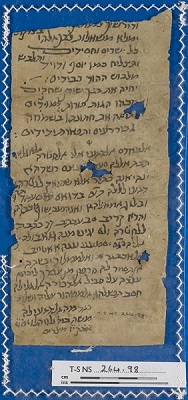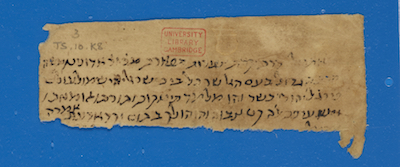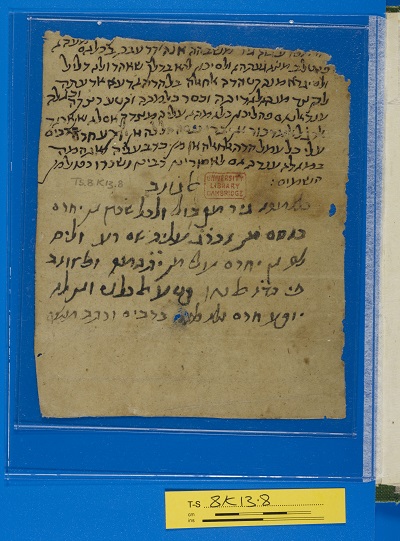On the identification and biography of the ‘poet for all seasons’ and his contact with Maimonides:
T-S 10K8.3, T-S 8K13.8 and T-S NS 264.98
by Amir Ashur, The Center for the Study of Conversion and Inter-Religious Encounters
In the FOTM of April 2011 I referred to an unknown poet who wrote a poem in honor of Maimonides, along with some other poems honouring distinguished members of the community. At that point I was not able to identify the poet by his name.
Recently I was able to identify, thanks to the Friedberg Genizah Project Joins feature, another poem written and signed by the same scribe, dated to the year 1517 of the Era of Documents (1206 CE): T-S NS 264.98. His name is Moses b. Levi ha-Levi, well-known figure. His younger brother was the famous cantor of the Eretz-Israeli congregation in Fusṭāṭ, Yedutun ha-Levi.[1]
T-S NS 264.98
Continuing to search, I was able to discover more and more material written by him that sheds considerable light on his biography. From T-S 13J7.12 we learn that he was a resident of Qalyūb. Another important manuscript written by him is a poem describing his own life.[2] From this, we learn that for part of his life he was a businessman and was able to make a decent living. After a while he decided to quit business and become a scholar. Later on he complained that he had spent all his money on books, and was reliant on his parents to support him. After six months he moved to Qalyūb and served as a judge there.
T-S 10K8.3
T-S 8K13.8
As Blau pointed out in his edition of Maimonides’ responsa (vol. III, pp. 15–16), in most cases the senders of the original Judaeo-Arabic queries were anonymous, and he listed only four names known to him as senders. From this legal query we can add one more – the name of our poet, Moshe b. Levi ha-Levi. Furthermore, Blau also listed nine places from where the queries were sent to Maimonides, and now we can add another place to this list – Qalyūb. We can also assume that T-S Misc.8.90 also came from Qalyūb, and this is how our poet was able to lay his hands on it.
Acknowledgement
I wish to thank for Prof. M.A. Friedman for supplying me valuable information.
Bibliography
S. Elizur, ‘Individual Mourning and National Solace in Early Liturgical Poetry’, Ginzei Qedem 7 (2011), pp. 16–24.
M.A. Friedman, India Book IVA: Halfon and Judah ha-Levi – the lives of a merchant scholar and a poet laureate according to the Cairo Geniza documents (Hebrew; Jerusalem, 2013).
J. Schirmann, New Hebrew Poems from the Genizah (Jerusalem, 1965).
Footnotes
[1] On Moshe and Yedutun see Elizur, ‘Individual mourning’,pp. 16–24 and the sources cited there.
[2] This poem, from the David Kaufmann Collection in Budapest (DK 173) was published by Schirmann, New Hebrew Poems, pp. 377–384.
[3] These three figures were recently identified by Prof. M.A. Friedman as the judges in Maimonides’ court, see Friedman, India Book IVA, pp. 36–37. ‘Samuel’ is none other than Samuel b. Saʿadya ha-Levi who passed away in 1203, so Moses ha-Levi, our poet, passed away after this date.
Ashur, A. (2016). On the identification and biography of the ‘poet for all seasons’ and his contact with Maimonides: T-S 10K8.3, T-S 8K13.8 and T-S NS 264.98. [Genizah Research Unit, Fragment of the Month, November 2016]. https://doi.org/10.17863/CAM.8158
If you enjoyed this Fragment of the Month, you can find others here.
Contact us: genizah@lib.cam.ac.uk
The zoomable images are produced using Cloud Zoom, a jQueryimage zoom plugin:
Cloud Zoom, Copyright (c) 2010, R Cecco, www.professorcloud.com
Licensed under the MIT License



